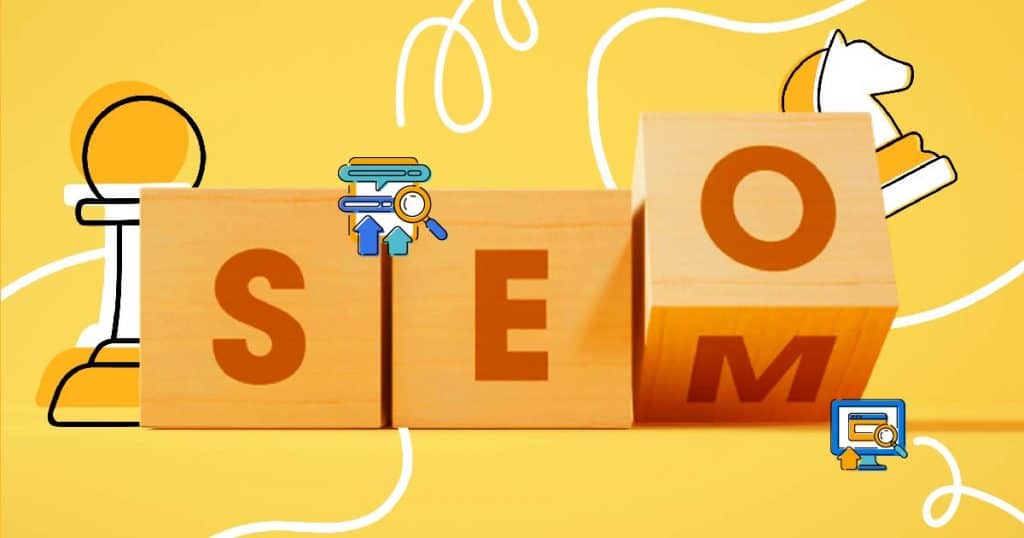Every marketer knows that great products and incredible services aren’t all that matters when running a successful digital-age business.
Without search engine visibility and top ranking on relevant SERPs, your target audience will never even know you’re out there.
That’s where essential tactics like SEO (search engine optimization) and SEM (search engine marketing) come in.
However, far too many marketers still don’t understand the details of SEO vs SEM. Quite a few still even use the terms interchangeably.
While SEO and SEM are both vital parts of a solid search marketing strategy, they’re two very different things.
Here’s a closer look at the critical differences between the two and some tips for successfully using both in your marketing efforts.
- What is SEO?
- What is SEM?
- SEO vs SEM: The Difference Explained
- Can SEO and SEM Work Together?
- How to Improve Your SEO and SEM Strategies
- Wrap Up: Get More Out of Your SEO and SEM Strategies
What is SEO?
Search engine optimization (or SEO) is the portion of a search marketing campaign that focuses on organic marketing efforts and results.
Think higher rates of organic traffic, more organically generated conversions, and so forth.
Since Google’s algorithm is always changing and becoming progressively smarter, SEO is constantly evolving, as well.
For that reason, a great SEO strategy isn’t about any one tactic. Most ongoing SEO strategies include all or most of the following, as they all help boost organic reach and raise organic SERP ranking.
- Keyword-optimized written page content and blog posts.
- Use of targeted keywords in alt text, title tags, metadata, headings.
- Strategically chosen page URLs.
- Focus on website speed.
What is SEM?
Search engine marketing (or SEM) is similar to SEO.
However, one of the biggest SEO vs SEM differences here is that SEM includes a focus on paid results.
Commonly utilized paid tactics include (but aren’t necessarily limited to) pay-per-click (PPC) advertising and sponsored posts.
Another key distinction is that the term “SEM” can often refer to a much broader marketing strategy that isn’t necessarily limited to paid strategies, because you can’t have an effective SEM strategy without SEO.
For example, PPC Google ads are useless without keyword research, and sponsored posts aren’t effective without good content production techniques plus social media expertise.
You’ll also need Google to see you as an authority and your website as respectable before it will grant a high ranking to your PPC ads.
That can only happen through thorough ongoing SEO practices.
SEO vs SEM: The Difference Explained
The main difference between SEO vs SEM is that SEO is strictly about organic strategies, while SEM will always include at least the possibility of paid strategies.
These two concepts work so closely together that it’s very common for people to use the terms interchangeably. But they’re not the same thing, so it’s essential to be able to distinguish between the two.
It’s also worth noting that both SEO and SEM have distinct advantages.
For instance, paid SEM tactics like PPC are great ways to boost visibility quickly, as with a new business or timely product launch.
But you’ll still need to understand SEO to make your PPC ad successful. SEO is also vitally important for boosting long-term, high-value organic SERP visibility.
Can SEO and SEM Work Together?
Not only can SEO and SEM work together, but a genuinely well-rounded marketing strategy should include both.
Marketers should also ensure that their SEO and SEM strategies complement one another via thorough ongoing keyword research.
Strategically using the two together has benefits like:
- Quicker results.
- Better quality web traffic (and more of it).
- A good mixture of top-of-funnel and bottom-of-funnel leads.
- Higher levels of brand awareness.
- Better, more thorough data.
As you can see, the natural choice isn’t between SEO vs SEM. It’s how best to use the two strategies simultaneously to meet your business goals and help your company grow.
How to Improve Your SEO and SEM Strategies
Again, SEO and SEM aren’t interchangeable terms. However, you will need to hone the same basic skills, techniques, and approaches to succeed with either one.
Here’s a closer look at what you need to know to get ahead with both of them.
1. Start with thorough keyword research
Well-researched, carefully chosen keywords are at the heart of both SEO and SEM, so any campaign should start with a round of focused keyword research.
A great keyword research tool can help take some guesswork out of the process, and many of the best, most commonly used options out there (like Google Keyword Planner, to name just one) are even free.
You’ll also need to understand the fundamentals of choosing initial keywords to get started with.
Put yourself into your customer’s shoes. How might they word a search for information or possible product options? What questions and concerns might that customer have that you could answer for them?
Use what you come up with to brainstorm unique long-tail keywords. This will help refine your results and help you stand out from the rest of the competition.
What advantages does your company have over your competitors? What does your product, service, or brand do that the others don’t?
2. Optimize your existing web content
Once you’ve got a well-rounded list of keywords to work from, it’s time to start finetuning your website so that Google will see it as a good fit for searches on those terms.
Build standalone pages that address fundamental concerns a visitor might have about your brand, products, or services.
But don’t include too many different types of information on any single page.
For instance, if your business serves multiple locations or offers various services, each should have its own dedicated page that revolves around an appropriate set of keywords.
It’s also crucial to use your keywords wisely. Don’t stuff your content with keywords. Instead, use them naturally throughout your content.
You’ll also want to be sure to add them in the right places. For instance:
- Early on in your content or toward the top of the page.
- In headings and subheadings where it makes sense.
- In title tags, meta descriptions, and metadata.
- In image alt text.
3. Create a user-friendly site experience
Today’s web users and consumers have high expectations for the sites where they spend their time, especially if they’re thinking about making a purchase.
For instance, they aren’t willing to wait around forever for a slow site to load or spend a lot of time hunting for the information they need.
So make sure your site is fast, functional, and loads quickly. It should be easy to navigate, as well, as you ideally want your visitors to stick around after reading your landing page and check out more of your content.
Mobile-friendliness is important, as well. In 2021, as many as 90 percent of global web users habitually accessed the internet via a mobile device.
These numbers will only continue to rise as mobile use increasingly becomes the norm.
Google is in the business of providing web searchers with solutions and answers of the best available quality.
Great content relevant to the person’s search is only part of what Google looks at to determine SERP ranking. The rest is about user experience, so make it a priority.
4. Use ongoing content production to deliver value
Whether you’re currently focusing on SEO vs SEM or leveraging a balanced mix of the two, it’s crucial to understand that Google favors frequently updated websites with plenty of relevant, high-quality content.
One of the most effective ways to deliver this is to add a blog to your website, set a fixed content production schedule, and post new material accordingly.
Aim to provide tangible value throughout every stage of the buyer’s journey.
Your top-of-funnel leads will have just started looking for solutions to a particular issue. They need background information, informative content, and helpful resources like buying guides.
Others will have settled on a specific type of solution and will be comparison shopping.
Finally, there are customers who’ll be looking to finalize a purchase, make complementary purchases, or find answers to maintenance questions.
Fantastic SEO and SEM campaigns seek to deliver value to all of these customers, so plan your marketing material accordingly.
Looking for an easy way to scale your content production while ensuring high quality? Start WriterAccess’ 14-day trial right now!
5. Make sure your business goals and campaign strategies are in sync
Making sure your approaches to SEO and SEM are entirely in step with your current goals for your business is crucial.
Are you currently looking to boost brand awareness and public perception? Maybe you’re working on attracting new customers or even looking to break into an entirely new market.
SEM, in particular, can be beneficial for quickly exposing your brand and product catalog to new users, so make sure your current list of targeted keywords, recent publishing efforts, and social media posts are all in line with what you’re trying to accomplish.
6. Use SEM to support the rest of your investment
The more effectively your SEO and SEM strategies complement one another, the more you will get out of either effort.
Here are some key factors to consider.
- Customers who click on paid ads (whether on SERPs or social media) are more likely to buy and spend more.
- Conversion rates can rise up to 52 percent when search and display efforts adequately support one another.
- Branded search volume tends to spike for many days after a far-reaching TV spot or viral social media asset makes the rounds.
You need SEO and SEM (not SEO vs SEM) to make the most of these occurrences, so strengthen your keyword coverage across the board to maximize results.
Wrap Up: Get More Out of Your SEO and SEM Strategies
As you can see, an effective comparison of SEO vs SEM shows savvy marketers use both to varying degrees as they relate to their ongoing goals.
However, best practices for both options are constantly changing, so staying ahead of the game means periodically assessing the maturity of your current SEO strategy.
Check out our informative SEO maturity assessment to see how your strategy measures up. Identify strengths, target weaknesses, and learn everything you need to know to move forward to the next stage!

![[WA] Ultimate Content Marketing Kit](https://rockcontent.com/wp-content/uploads/2022/08/Content-Marketing-Kit-750x200px.jpg)








